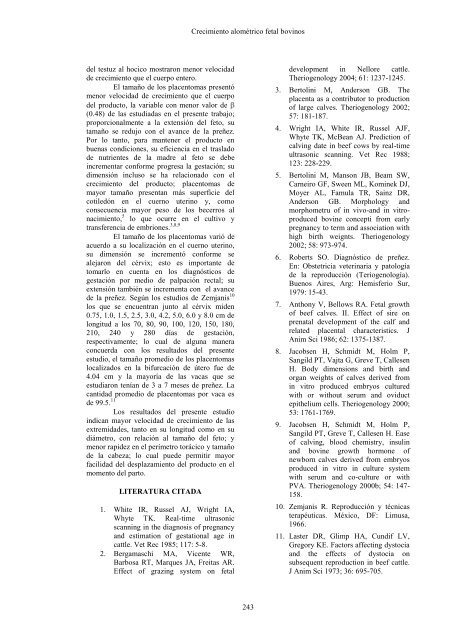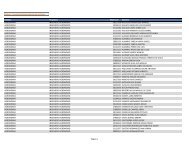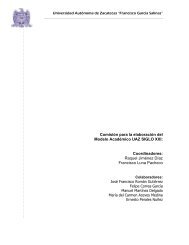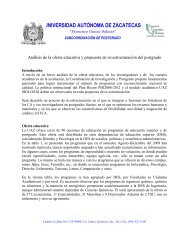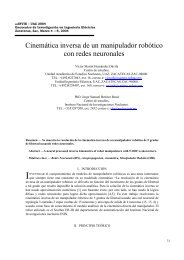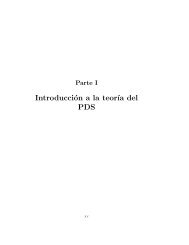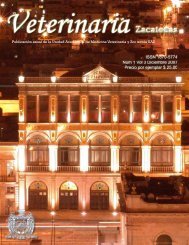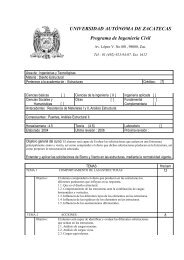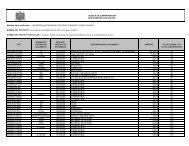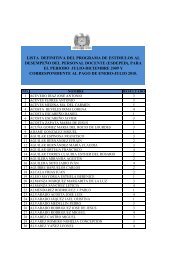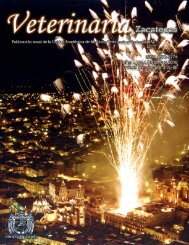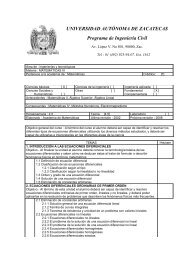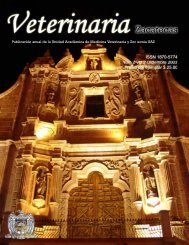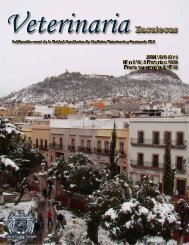Revista Veterinaria Zacatecas 2006 - Universidad Autónoma de ...
Revista Veterinaria Zacatecas 2006 - Universidad Autónoma de ...
Revista Veterinaria Zacatecas 2006 - Universidad Autónoma de ...
Create successful ePaper yourself
Turn your PDF publications into a flip-book with our unique Google optimized e-Paper software.
Crecimiento alométrico fetal bovinos<br />
<strong>de</strong>l testuz al hocico mostraron menor velocidad<br />
<strong>de</strong> crecimiento que el cuerpo entero.<br />
El tamaño <strong>de</strong> los placentomas presentó<br />
menor velocidad <strong>de</strong> crecimiento que el cuerpo<br />
<strong>de</strong>l producto, la variable con menor valor <strong>de</strong><br />
(0.48) <strong>de</strong> las estudiadas en el presente trabajo;<br />
proporcionalmente a la extensión <strong>de</strong>l feto, su<br />
tamaño se redujo con el avance <strong>de</strong> la preñez.<br />
Por lo tanto, para mantener el producto en<br />
buenas condiciones, su eficiencia en el traslado<br />
<strong>de</strong> nutrientes <strong>de</strong> la madre al feto se <strong>de</strong>be<br />
incrementar conforme progresa la gestación; su<br />
dimensión incluso se ha relacionado con el<br />
crecimiento <strong>de</strong>l producto; placentomas <strong>de</strong><br />
mayor tamaño presentan más superficie <strong>de</strong>l<br />
cotiledón en el cuerno uterino y, como<br />
consecuencia mayor peso <strong>de</strong> los becerros al<br />
nacimiento, 5 lo que ocurre en el cultivo y<br />
transferencia <strong>de</strong> embriones. 3,8,9<br />
El tamaño <strong>de</strong> los placentomas varió <strong>de</strong><br />
acuerdo a su localización en el cuerno uterino,<br />
su dimensión se incrementó conforme se<br />
alejaron <strong>de</strong>l cérvix; esto es importante <strong>de</strong><br />
tomarlo en cuenta en los diagnósticos <strong>de</strong><br />
gestación por medio <strong>de</strong> palpación rectal; su<br />
extensión también se incrementa con el avance<br />
<strong>de</strong> la preñez. Según los estudios <strong>de</strong> Zemjanis 10<br />
los que se encuentran junto al cérvix mi<strong>de</strong>n<br />
0.75, 1.0, 1.5, 2.5, 3.0, 4.2, 5.0, 6.0 y 8.0 cm <strong>de</strong><br />
longitud a los 70, 80, 90, 100, 120, 150, 180,<br />
210, 240 y 280 días <strong>de</strong> gestación,<br />
respectivamente; lo cual <strong>de</strong> alguna manera<br />
concuerda con los resultados <strong>de</strong>l presente<br />
estudio, el tamaño promedio <strong>de</strong> los placentomas<br />
localizados en la bifurcación <strong>de</strong> útero fue <strong>de</strong><br />
4.04 cm y la mayoría <strong>de</strong> las vacas que se<br />
estudiaron tenían <strong>de</strong> 3 a 7 meses <strong>de</strong> preñez. La<br />
cantidad promedio <strong>de</strong> placentomas por vaca es<br />
<strong>de</strong> 99.5. 11 Los resultados <strong>de</strong>l presente estudio<br />
indican mayor velocidad <strong>de</strong> crecimiento <strong>de</strong> las<br />
extremida<strong>de</strong>s, tanto en su longitud como en su<br />
diámetro, con relación al tamaño <strong>de</strong>l feto; y<br />
menor rapi<strong>de</strong>z en el perímetro torácico y tamaño<br />
<strong>de</strong> la cabeza; lo cual pue<strong>de</strong> permitir mayor<br />
facilidad <strong>de</strong>l <strong>de</strong>splazamiento <strong>de</strong>l producto en el<br />
momento <strong>de</strong>l parto.<br />
LITERATURA CITADA<br />
1. White IR, Russel AJ, Wright IA,<br />
Whyte TK. Real-time ultrasonic<br />
scanning in the diagnosis of pregnancy<br />
and estimation of gestational age in<br />
cattle. Vet Rec 1985; 117: 5-8.<br />
2. Bergamaschi MA, Vicente WR,<br />
Barbosa RT, Marques JA, Freitas AR.<br />
Effect of grazing system on fetal<br />
<strong>de</strong>velopment in Nellore cattle.<br />
Theriogenology 2004; 61: 1237-1245.<br />
3. Bertolini M, An<strong>de</strong>rson GB. The<br />
placenta as a contributor to production<br />
of large calves. Theriogenology 2002;<br />
57: 181-187.<br />
4. Wright IA, White IR, Russel AJF,<br />
Whyte TK, McBean AJ. Prediction of<br />
calving date in beef cows by real-time<br />
ultrasonic scanning. Vet Rec 1988;<br />
123: 228-229.<br />
5. Bertolini M, Manson JB, Beam SW,<br />
Carneiro GF, Sween ML, Kominek DJ,<br />
Moyer AL, Famula TR, Sainz DR,<br />
An<strong>de</strong>rson GB. Morphology and<br />
morphometru of in vivo-and in vitroproduced<br />
bovine concepti from early<br />
pregnancy to term and association with<br />
high birth weignts. Theriogenology<br />
2002; 58: 973-974.<br />
6. Roberts SO. Diagnóstico <strong>de</strong> preñez.<br />
En: Obstetricia veterinaria y patología<br />
<strong>de</strong> la reproducción (Teriogenología).<br />
Buenos Aires, Arg: Hemisferio Sur,<br />
1979: 15-43.<br />
7. Anthony V, Bellows RA. Fetal growth<br />
of beef calves. II. Effect of sire on<br />
prenatal <strong>de</strong>velopment of the calf and<br />
related placental characteristics. J<br />
Anim Sci 1986; 62: 1375-1387.<br />
8. Jacobsen H, Schmidt M, Holm P,<br />
Sangild PT, Vajta G, Greve T, Callesen<br />
H. Body dimensions and birth and<br />
organ weights of calves <strong>de</strong>rived from<br />
in vitro produced embryos cultured<br />
with or without serum and oviduct<br />
epithelium cells. Theriogenology 2000;<br />
53: 1761-1769.<br />
9. Jacobsen H, Schmidt M, Holm P,<br />
Sangild PT, Greve T, Callesen H. Ease<br />
of calving, blood chemistry, insulin<br />
and bovine growth hormone of<br />
newborn calves <strong>de</strong>rived from embryos<br />
produced in vitro in culture system<br />
with serum and co-culture or with<br />
PVA. Theriogenology 2000b; 54: 147-<br />
158.<br />
10. Zemjanis R. Reproducción y técnicas<br />
terapéuticas. México, DF: Limusa,<br />
1966.<br />
11. Laster DR, Glimp HA, Cundif LV,<br />
Gregory KE. Factors affecting dystocia<br />
and the effects of dystocia on<br />
subsequent reproduction in beef cattle.<br />
J Anim Sci 1973; 36: 695-705.<br />
243


